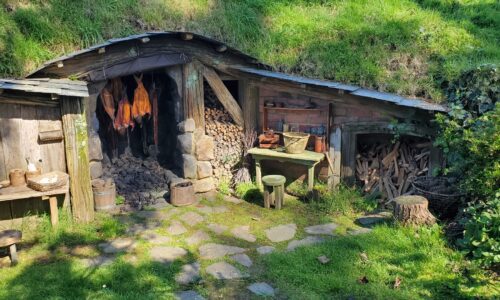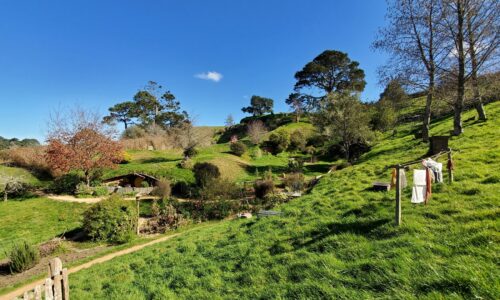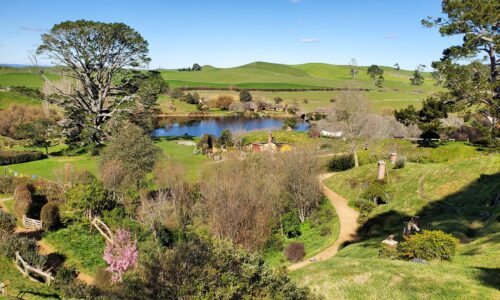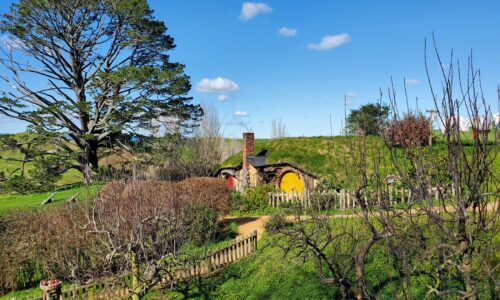Round the World – New Zealand 2, Part 2
A few days later it was time to head out of Auckland towards New Zealand’s South Island. First though I’d spend a few nights with a friend in Rotorua, as well as visiting the “Hobbiton” filming location from the Lord of the Rings and Hobbit films.

The good weather was back and the sun beat down on me as I pulled Planey out of the hangar and closed the doors behind us. Even late winter in North Island New Zealand offered T-shirt temperatures, and I was starting to get used to it. Nowhere is too far away from anywhere else in New Zealand and it would be a flight of just an hour down to the city of Rotorua.

I spent the afternoon in Rotorua town center, wandering around and enjoying the sunshine.
The next day my friend and I took the car over to Hobbiton, about an hour’s drive away. As with other tourist locations things were fairly quiet, which made it a pleasant experience. We lined up in a socially distanced manner and boarded a bus for the ride from the visitor center over to the Hobbiton set. Even before Hobbiton came into view it was clear why the director had chosen this location for the set; the rolling hills with mountain backdrop evoked Middle Earth perfectly.
Construction on the location had started in early 1999, a year before it was used for filming. This was to allow time for it to weather and gain a somewhat lived-in feel. The original set had been built in a very temporary manner but after it started to gain popularity as a tourist destination the decision was made to rebuild it in a more permanent way in 2010 for filming of The Hobbit.
Tours were well polished, starting off with a walk through the 30+ Hobbit holes. They had been built to varying scales, so that different holes could be used depending on whether the character in the foreground was meant look small or large.
Making our way up the hill we arrived at the unmistakable Bag End, situated with expansive views over the rest of Hobbiton, the lake, and the Green Dragon Tavern. After the obligatory photo stop it was time to make our way down the hill for a drink and a snack in the Green Dragon which turned out to be served by the farm owner himself.
An excellent Italian meal at a small restaurant in Rotorua rounded out the stay, and almost before I knew it, it was time to continue south to a new destination for me; the city of Nelson.
My friend dropped me at the airport and I made my way through the gate to head back to the aircraft. A familiar-looking Cessna 172 was parked at the fuel pumps, with a familiar looking man and boy standing next to it; it was Andy Hintz and his son, who I’d met back in March at the Ardmore Airport open day. We spent a while catching up; they were just back from a multi-day trip to the South Island. Andy and I organised to have a phone conversation in a few day so that he could interview me for an article in the Aircraft Owners and Pilots Association (AOPA) NZ. We said our goodbyes and I pre-flighted before setting off south for my first stop, a fueling stop at Whanganui.
Mostly clear skies meant that Mt Ruapehu and the smaller peaks north of it were clearly visible. I even had a good view of Mt Taranaki out to the west. I circled over the flank of Ruapehu once to take a closer look at the ski field; the slopes were pretty busy and it put the idea into my head of visiting Queenstown for a bit of skiing later in the month. I descended away from Ruapehu and made for the coastal town of Whanganui to fill up the tanks.

A couple of pilots were hanging around at the Whanganui aero club and welcomed me as I entered. They gave me some help refueling and we spent a while chatting about the trip and the pandemic (this was basically a daily conversation whenever I met somebody new). They kindly gave me their contact info in case I needed any assistance down the road, and invited me to come back and visit any time. I thanked them and headed out on the final flight of the day.
I decided to follow the shoreline rather than head straight across the water, both to minimise risk and to enjoy the scenery. Not being entirely sure of the NZ low flying rules (which I later clarified), I decided to stay a little above 500ft and slightly offshore as I flew along the coast. The occasional pedestrian waved to me as I passed, before I started a climb to 2,500ft for the crossing of the Cook Strait. A short hop over the water, with my life jacket for comfort, soon had me coasting in over Picton.
Nelson Tower cleared me into their airspace and directed me to a left downwind for runway 02. The visitor parking is on a grassy area at the far end of runway 02 and helpfully it has a few tie-down spots readily available to keep the aircraft secure. The only other occupant was a microlight with no propeller which had clearly been sitting there quite some time. After securing the aircraft I called the rental car company who turned up after just a couple of minutes to give me a lift to their office. It turned out that the manager used to be a commercial pilot himself and they had been tracking my arrival using an online flight tracker, explaining why they’d been ready to collect me so quickly!
It was just a ten minute drive to the home of my hosts Kevin and Shelley, broken by a stop at the bottle shop in the middle. I had been put in touch with them through the manager at Warbirds; the aviation connection being that Kevin is a retired captain for the Air Nelson regional branch of Air New Zealand. Their beautiful home is perched on top of a hill overlooking the airport; I could look out the windows and see Planey! I was delighted to discover that Shelley is an accomplished chef and dined very well that night as we chatted about flying and watched the sunset over the opposite hills.
My first day in Nelson was wet and gloomy. In search of indoor activities I drove into the town center and parked outside the Nelson Museum. The museum focuses on the Nelson area and covers subject matter ranging from the geological history of the region to the history and culture of the Maori and white settlers of the area. I found an hour to be enough time, before I was back out on the street in the drizzle.
It was only a block or two to the main pedestrian area and the Nelson Cathedral, which sits on a small hill overlooking the city. This cathedral boasts fairly modern architecture; it was completed in 1965 having taken 40 years to build. The building seats 350 people, the tower stands 35 meters high, and many aspects of the construction have earthquake resistance in mind; the original plans to use marble blocks in the construction were revised after the 1935 Murchison earthquake for example, and switched to ground marble mixed with plaster. The interior is a pleasing mixture of old-feeling architecture in a modern style (can you tell that I am in no way an architectural commentator?)
Conditions were somewhat better the following day. Nelson really comes into its own in good weather, and the city is apparently blessed with the most days of sunshine each year of anywhere in New Zealand. My first visit was to the Brook Waimarama Sanctuary, another predator-fenced region in the same style as the sanctuary I’d visited on Great Barrier Island. The sanctuary covers 700 hectares and was established in 2004. The valley was originally dammed in 1868 to provide water to Nelson, but this infrastructure became obsolete and was decommissioned in 2000. The valley also used to contain a railway servicing a chromite mine and two coal mines.
The hiking in the Brook sanctuary was rather more rugged than that in the reserve on GBI. I entered at 2pm, with the sanctuary closing at 4pm, so my chosen track (with a 2 hour predicted time to complete) would be cutting things close. A rain shower came through just as I was setting off so I ran back to the car for a jacket and headed off along the track. The lady at the counter had warned me that there were a number of river crossings without bridges, and I was only travelling with one pair of shoes; but no matter, I’d cross that bridge (or not) when I came to it.
The track started off heading up along the side of the valley, hill climbing with almost no respite. The occasional rain shower was quite welcome to help me cool off. The view every now and then when I came across a gap in the bush and could gaze out over the valley and take in the sights, was breathtaking. I passed a couple hiking in the other direction and ten minutes later came across an expensive waterproof jacket lying in the middle of the track. I added it to my collection of jacket plus fleece, and continued on my way.
The half way point of the track was the turnaround, where the walk moved off the valley wall and down to follow the Brook back downhill. Things became much more enclosed and wet, and the river crossings soon began. I elected to remove my shoes and socks and carry them across; the water was bitterly cold and I could barely feel my toes within seconds of wading in! I managed to make it back to the visitor center without falling in, shortly before closing time, and handed in the wayward jacket.
I started the next day off with a good look around the Thatcher CX5 aircraft being built by my host Kevin in his garage. This is a plan-built, tandem seating aircraft which Kevin was making a number of significant personalisations to, including conversion to tailwheel configuration and installation of a larger engine! The workmanship was excellent and it was exciting to see it nearing completion. The main tasks remaining were installation of the avionics, painting, and finding an airstrip for the first flights!

I went into town to attend the renowned Nelson market. It was starting to feel at this stage like every town I went to had a “renowned” market but it was always good fun to take a look around anyway! Regrettably it turned out that the market had still not restarted after the COVID lockdown earlier in the year so I made do with a waffle and icecream at the Penguino icecream cafe nearby.
I took a stroll through the town and ended up at ANZAC park, home to the cenotaph recognising those from the Australian and New Zealand army corps who lost their lives in the World Wars. New Zealand in particular, out of all the countries I had visited, seemed to take memorialising their war dead very seriously; perhaps one reason that they seem to take part in rather less conflict in modern times than some other countries.
The next day I decided to visit “The center of New Zealand”. Nelson lays claim to this geographical point, which in a suspiciously convenient coincidence is located on top of a pleasant hill with great views of the city. A bit of reading revealed the reason for this; the marker does not in fact mark the geographic center of New Zealand, but in fact the “zero, zero” point to which the first geodetic surveys of New Zealand were referenced. The actual geographic center of New Zealand lies about 60km southwest of Nelson in the “Big Bush” conservation area.
The walk up to the marker can be started from any of a variety of points around the base of the hill and takes around 30 minute. The walker is rewarded with stunning views of Nelson city and the surrounding hills; the location was chosen to allow survey marks in surrounding regions to be triangulated and referenced so good lines of sight were essential.
From the Center of New Zealand I drove to the northern end of Nelson City to visit the Founder’s Heritage Park. This museum houses a number of old or reproduction buildings. Many of these have been relocated from other areas and positioned to create a historical village offering an idea of how the earlier European settlers would have lived. A short heritage railway line is operated by the Nelson Railway Society. A number of the old buildings house shops, museums and other establishments operated by local heritage groups.
The park opened to the public in 1986 and is now managed by the council. Being a weekday afternoon it was fairly quiet and I was able to wander around at my leisure, almost as if it were a private tour. The maritime displays of model ships, mostly those involved in Nelson’s past, were particularly worth a visit.
I finished off my afternoon with a visit to the Natureland wildlife trust at Tahunanui beach. This small zoo was taken over in recent years after getting into difficulties, and now focuses on conservation and education. There were plenty of school children around enjoying watching the animals, which were a mix of exotic species, imported domestic species, and New Zealand native animals. The very large rabbits were a particular highlight, although one could not stroke them!
On Saturday, at the suggestion of Shelley, I drove over the Takaka Hill to the Anatoki Salmon farm. Recent rains had swept away large sections of the road and reconstruction was ongoing; a large section of the road was single-lane only, controlled by traffic lights with a 15 minute countdown. Naturally, I arrived at the lights moments after they turned red, and had a long wait until our lane of traffic was able to snake its way up the hill. The weather had turned again with low cloud and drizzle setting in, and before long the view was completely obscured behind a blanket of white. This did at least mean that the drive was relatively quick, with minimal stops to take in the sights!
Anatoki salmon farm allows one to catch one’s own salmon, and have it prepared in any manner you want. I was handed a rod and a plastic box with a knife in it, and sent off to the lake. I spent quite some time casting and re-casting my line, with similarly unsuccessful tourists either side of me. Across the lake a 6 year old child was reeling salmon in one after the other so I went and stood next to them in the hope of copying the technique. Their father gave me some tips and soon I had a big juicy salmon in my box. When I asked them to prepare half smoked and half sashimi I didn’t realise they would serve me the entire fish for lunch then and there; fortunately they were happy to provide a takeaway box for the remainder.
Before returning over the hill I stopped in to the Te Waikoropupu Springs. These springs are renowned for the clarity of their water, until recently considered only second to sub-glacial water in the Antarctic (more recently Blue Lake in the same area of New Zealand has been measured to have even more impressive visibility). The volume of the spring is also notable, with more than 14,000 liters per second water coming out of the 8 main vents.
The weather was no better on the drive back and once again I caught the light just as it turned red. The next day it would be time to move on, further south down New Zealand.
Click here to read the next part of the story.




































































